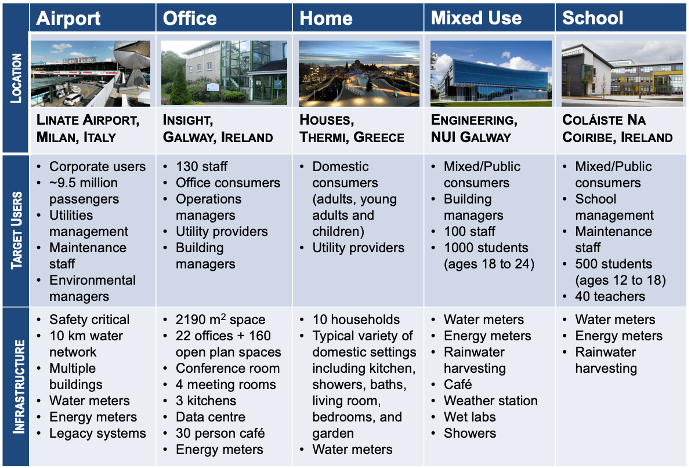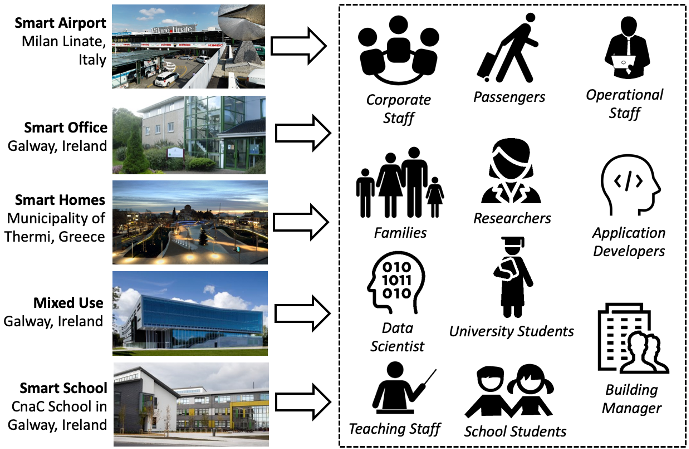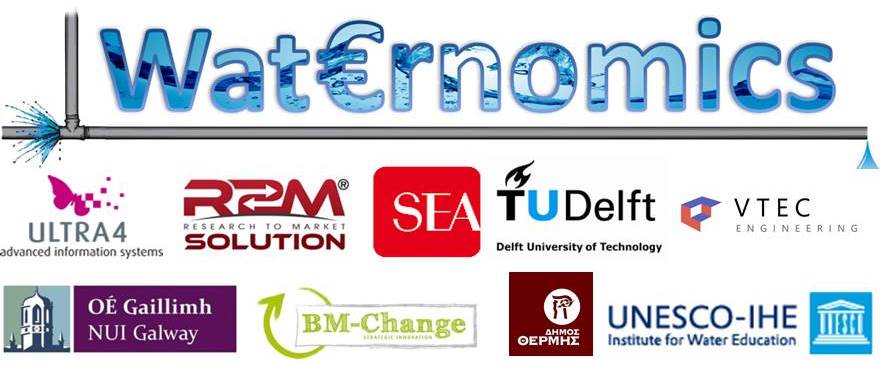Pilots
Over the past number of years, we have been involved in a number of projects (Curry et al., 2013) (Aggarwal, Ashish and Sheth, 2014) (Curry et al., 2014) concerned with investigating the use of a Real-time Linked Dataspace as a data platform for intelligent systems within smart environments, specifically targeting intelligent systems for smart energy and water management. The five pilot smart environments are Airport, Office, Home, Mixed Use and School.

Smart Airport (Linate, Milan): Linate Airport represents large-scale commercial energy and water consumers with mixed water use from washing activities, toilets, restaurants, flight operations, to safety critical infrastructure for emergency response. The intelligent systems and applications in Linate target a variety of users in a business environment (including executives, operational managers, and technical staff), each one having a specific role in the company’s structure. Apart from the company’s employees, applications also target the airport passengers representing the public. Multiple legacy building management systems are in use across the different buildings. The variety of sensors used in the airport require the management of heterogeneous events and their availability to applications in near-real-time. Significant contextual data from the airport’s operational systems are needed to process the events for decision-making, presenting significant challenges with legacy data integration and access control.
Smart Office (Galway, Ireland): The Insight Building hosts approximately 130 staff in a dedicated building with 2190m2 of space, comprising offices, open plan workspaces, a 90-seat conference room, four meeting rooms, three kitchens, one air-conditioned data centre, and a 30-person café. The building was built in the 1990s and did not employ a building management system or an energy management system. The building has been retrofitted with energy sensors and a simple energy management system. As typically in an organisation, Insight has several information systems that run its operations, including finance and enterprise resource planning, budgeting, and Office IT assets. These enterprise systems can help in identifying energy wastage and promote conservation actions.
Smart Homes (Municipality of Thermi, Greece): The Municipality of Thermi in Greece provides a residential smart water pilot constituting a representative sample of 10 domestic residences with different profiles. The target audience of smart home water applications are the resident adults and children. Other interested users include the municipality management and a developer community for smart home “Apps”, research scientists, and the local water utility. Data from Internet of Things (IoT) devices in each home needs to be managed in a near-real-time manner to provide feedback to users on their water consumption. Sensor data needs to be enriched and linked to entities describing the households’ water outlets. Securely sharing datasets with both the research and the developer community was an essential requirement.
Mixed Use (Galway, Ireland): The Engineering Building at NUI Galway is a state-of-the-art smart building with large quantities of sensors and actuators for its management. This smart environment is designed to be a ‘living laboratory’ where the building itself is an interactive teaching tool. The building includes lecture halls, classrooms, offices, laboratory facilities, café, showers, and bathrooms. Intelligent energy and water applications target staff members, managers, technicians, researchers, and students. As with the smart home example, the requirement to make data easily reusable by occupants in the environment is an important requirement. Also, staff members are interested in understanding usage behaviours and detecting saving opportunities, and students are interested in visualising the building consumption and utilising data from the environment in their projects and research works.
Smart School (Galway, Ireland): Coláiste na Coiribe is an Irish language secondary school that has been newly constructed at a suburban location in Galway City in Ireland. It includes classrooms, offices, sports halls, and associated toilet and shower facilities. The school accommodates students aged 12 to 18, together with teaching and operational staff. The school has been fitted with a commercial state-of-the-art building management system to manage its energy and water consumption. An essential requirement in this environment is to customise the communication of water and energy data for the diverse range of school stakeholders.
Target Users Groups

Smart environments can engage a wide range of end-users with different interests and priorities, from corporate managers looking to improve the performance of their business to school children who want to explore and learn more about sustainability and their effects on the environment. The target users across the five pilot smart environments are:
- Building Managers and Operations Staff: Managers, technicians, and engineers as well as other staff members with responsibility for the operations of buildings. These are adult users that have an advanced level of education and are highly skilled.
- Passengers: Passengers that range from business travellers to a variety of casual travellers from different age groups, from kids to adults.
- Corporate Staff: Office and administration staff that are found in a typical organisation. These adults are often highly educated and skilled (e.g. administration, HR, marketing, and sales), but not in the technical area of energy and water management.
- Families: Family units with potentially multiple generations in one home, including children, young adults, adults, parents, and grandparents.
- Teaching Staff: Teaching staff at both university and school levels looking to use the smart environment as a teaching aid within their classes.
- University Students: Undergraduate and research students are interested in understanding their environment and using the data in their projects and research works. The age groups of this group range from young adults to adults.
- School Students: School students ranging from kids to young adults.
- Data Scientists: Leverage algorithms and machine learning to extract knowledge and insights from data in the smart environment.
- Researchers: Advanced users who want to analyse the data from the smart environment within their research work.
- Application Developers: Software and application developers who want to create intelligent applications (including data analytics) for the users within the pilots.
Enabling Intelligent Systems, Applications, and Analytics for Smart Environments
Within a smart environment, data platforms such as Real-time Linked Dataspaces (RLD) (Curry et al., 2019) are valuable for application developers and data scientists as they constitute a one-stop-shop of all the data required for building their intelligent applications or analytics: open data, enterprise data, and sensor data. RLD include public or private data sources that can be used to drive innovations and new solutions within the smart environment. The RLD has been used to provide source selection for real-time predictive analytics, personalised applications for users, and enhanced user experiences for intelligent systems within smart environments.
- Predictive Analytics: A data platform giving access to IoT and open data sources is particularly promising when creating real-time predictive data analytics for decision support within intelligent systems. The main challenge here is the dynamic selection of sources from the dataspace to support predictive analytics. In this context, we are interested in the study of automatic source selection for prediction models in the energy domain using open data and IoT. We presents an autonomic computing inspired approach to source selection for training deep neural networks and machine learning algorithms within the RLD.
- Intelligent Applications and Digital Twins: A key challenge in delivering smart environments is creating effective applications for end-users with new digital infrastructures within the environment. We reflect on the experience of using the RLD for developing over 25 different IoT-based intelligent applications and digital twins within five different smart environments, from Airports to Schools. The goal of these has been to engage users within intelligent systems to increase water and energy awareness, management, and conservation. The overall design philosophy of the intelligent applications and digital twins has been guided using Boyd’s “OODA Loop” for decision-making.
- User Experience: Creating a compelling user experience within a smart environment (from smart buildings to smart cities) is an essential factor to success. We reflect on our experience of developing IoT-based intelligent applications using the RLD where the goal has been to engage a wide range of users (from building managers to business travellers) to increase water and energy awareness, management, and conservation. The design of the experience is defined using an IoT enhanced model for user experience. The user journey within the smart environment is supported by leveraging the Transtheoretical Model of behaviour change to influence a person’s attitude positively towards sustainable behaviour.
Further details on the pilots are available from the Waternoics.eu project website.
References
Aggarwal, C. C., Ashish, N. and Sheth, A. (2014) ‘The internet of things: A survey from the data-centric perspective’, in Managing and Mining Sensor Data, pp. 383–428. doi: 10.1007/978-1-4614-6309-2_12.
Curry, E. et al. (2013) ‘Linking building data in the cloud: Integrating cross-domain building data using linked data’, Advanced Engineering Informatics, 27(2), pp. 206–219. Available at: http://www.edwardcurry.org/publications/Curry_AEI_2013.pdf.
Curry, E. et al. (2014) ‘Linked Water Data For Water Information Management’, in 11th International Conference on Hydroinformatics (HIC 2014). New York, New York, USA. Available at: http://www.edwardcurry.org/publications/Curry_HIC2014.pdf.
Curry, E. et al. (2019) ‘A Real-time Linked Dataspace for the Internet of Things: Enabling “Pay-As-You-Go” Data Management in Smart Environments’, Future Generation Computer Systems, 90, pp. 405–422. doi: 10.1016/j.future.2018.07.019.
